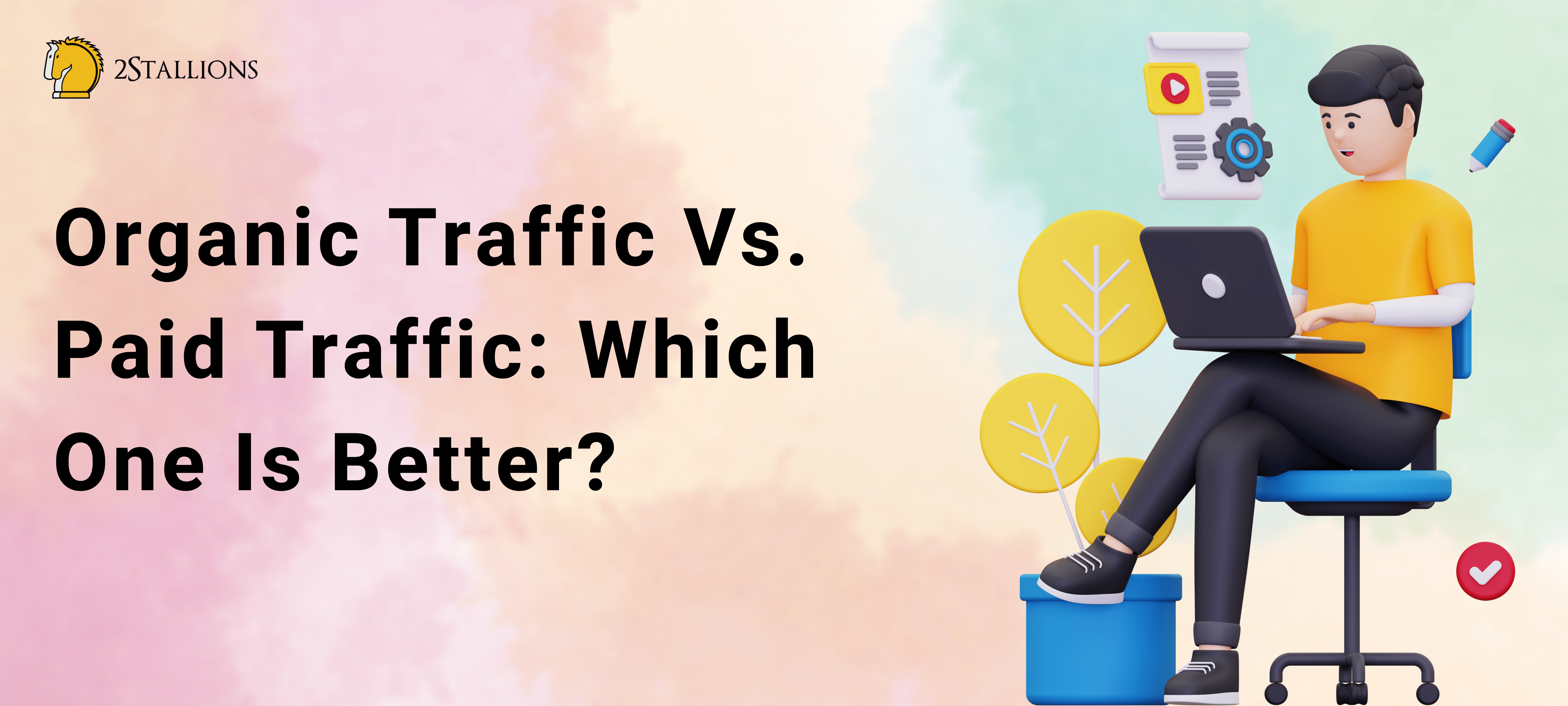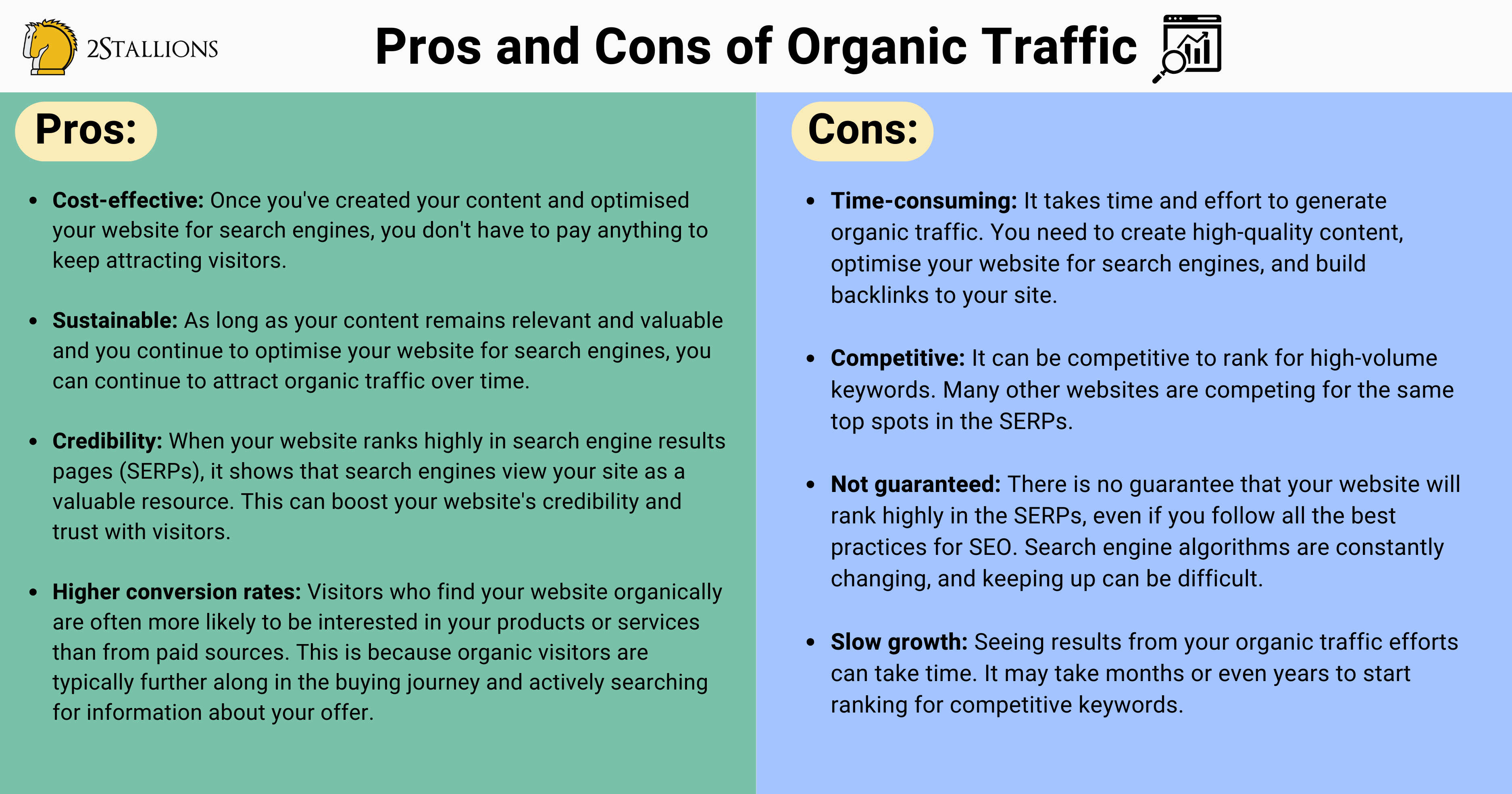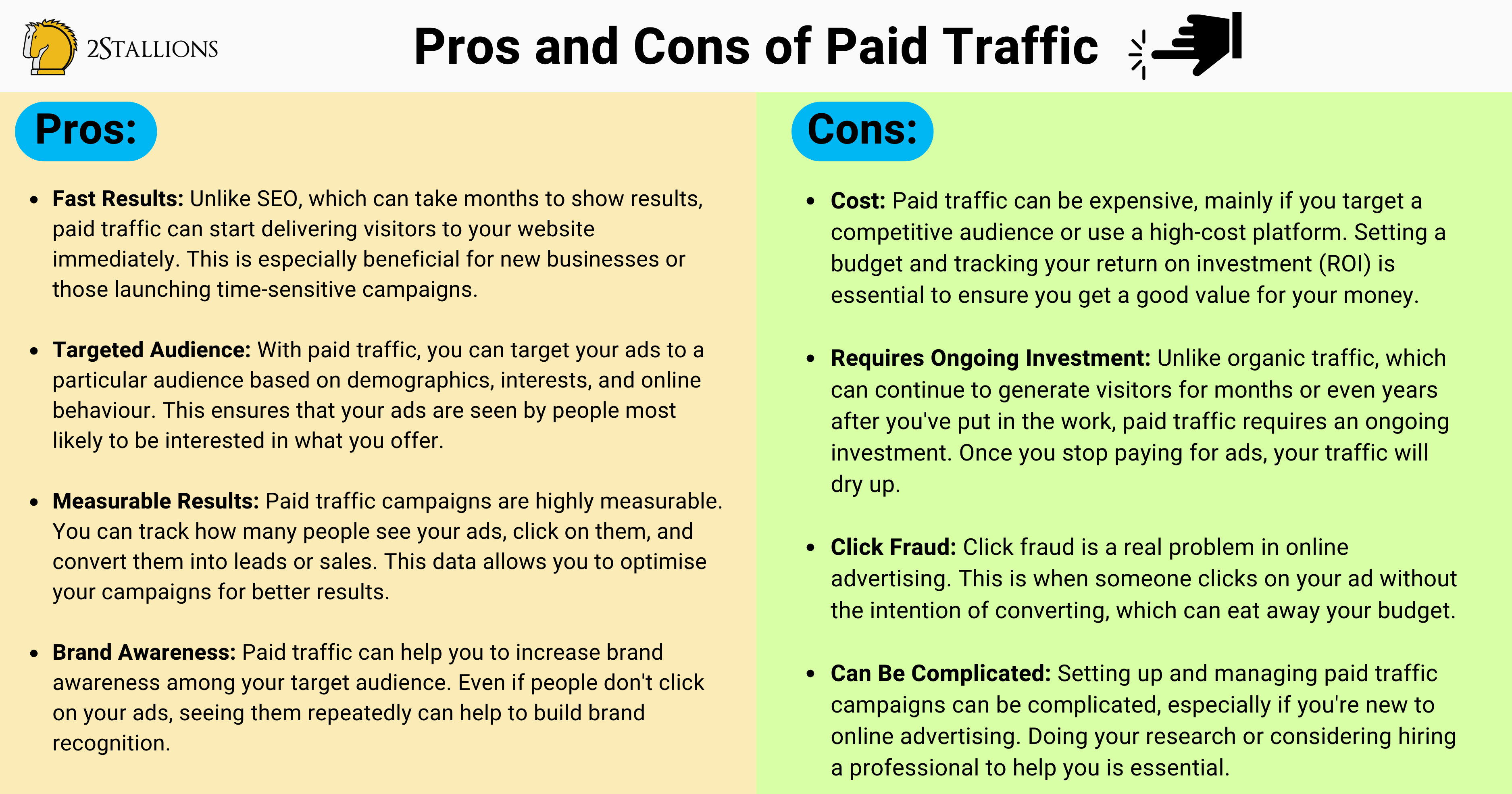Content
SHARE

In the vast digital marketing landscape, organic traffic and paid traffic are two primary ways to drive traffic to your website. Both methods have their own set of advantages and disadvantages. Understanding the basics of website traffic is crucial for any business looking to make an impact in the online world.

Understanding The Basics of Website Traffic
Website traffic is a crucial aspect of any online business or website. It determines the number of visitors who access your website and plays a significant role in your online success. There are different types of website traffic, including organic and paid traffic, each with unique characteristics and benefits.
What Is Organic Traffic?
Organic traffic refers to the visitors who find your website through unpaid search engine results. When users search for relevant keywords, your website appears in the search engine results pages (SERPs), and users click on it to access your content. Organic traffic often stems from your search engine optimisation (SEO) efforts, such as creating quality content, optimising meta tags, and building backlinks. The goal is to rank higher in SERPs to attract more organic traffic.
Organic traffic is precious as it indicates that users are genuinely interested in your website and its content. It is considered a more sustainable and long-term approach to driving traffic to your website. By consistently providing valuable and relevant content, you can attract steady organic traffic, leading to increased visibility, brand recognition, and potential conversions.
One of the advantages of organic traffic is that it tends to have a higher conversion rate than other types of traffic. Since users actively search for specific keywords related to your website, they are more likely to engage with your content and take desired actions, such as purchasing or subscribing to your newsletter.
What Is Paid Traffic?
Paid traffic, on the other hand, is generated through online advertising campaigns. You pay a fee to platforms like Google Ads or social media networks to display your ads to a targeted audience. When users click on your ads, they are directed to your website. Paid traffic allows instant visibility, as your ads are prominently displayed to potential customers. However, it requires a monetary investment and does not have the long-term benefits of organic traffic.
Paid traffic can be an effective strategy to quickly drive traffic to your website, especially if you have a new website or want to promote a specific product or service. It offers immediate results and allows you to reach a broader audience that may have yet to discover your website through organic means.
However, it is essential to note that paid traffic can be costly, especially if you are targeting highly competitive keywords or demographics. It requires careful planning and optimisation to ensure a good investment return. Additionally, paid traffic does not guarantee long-term success, as the traffic stops once you stop running your advertising campaigns.
Combining organic and paid traffic is often beneficial when considering your website traffic strategy. By leveraging the advantages of each type, you can maximise your website’s visibility, attract a diverse range of visitors, and ultimately achieve your online goals.
The Pros and Cons of Organic Traffic
Advantages of Organic Traffic
Organic traffic has several advantages over paid traffic. Firstly, it builds credibility for your brand. When users find your website through organic search results, they perceive it as a trusted source of information. Organic traffic also tends to have higher click-through and conversion rates as users search for relevant content. Moreover, organic traffic is cost-effective in the long run, as you don’t have to pay for each visitor to your site continually.
Disadvantages of Organic Traffic
However, there are drawbacks to relying solely on organic traffic. Improving your website’s ranking in search results takes time and effort. It requires continuous content creation, optimisation, and link building. Staying ahead of competitors vying for organic traffic can also be challenging. Additionally, changes to search engine algorithms can affect your website’s visibility and rankings, making it necessary to adapt your SEO strategies accordingly.
The Pros and Cons of Paid Traffic
Benefits of Paid Traffic
Paid traffic offers an array of benefits. It provides instant visibility and exposure to a targeted audience. Paid advertising platforms allow you to set specific parameters, such as demographics, interests, and location, to ensure your ads reach the right people. Paid traffic also offers more control over your campaigns, as you can monitor and adjust them in real time. It enables rapid testing of marketing messages and strategies to determine what works best for your business.
Drawbacks of Paid Traffic
Despite its advantages, paid traffic has certain drawbacks. It can be costly, particularly for small businesses with limited advertising budgets. Competition for ad space can drive up costs, and a high conversion rate is not guaranteed. Paid traffic also relies heavily on the quality of your ads and landing pages. If your ads are compelling or your landing pages must be optimised for conversions, you may not see a positive return on investment.
Comparing Organic and Paid Traffic
Cost Implications
One primary factor to consider when comparing organic and paid traffic is the cost. Organic traffic is unrestricted regarding the actual clicks to your site, but it requires time, skill, and resources to optimise your website and content. Meanwhile, paid traffic involves upfront costs in purchasing ad placements and ongoing expenses to maintain your campaigns.
Impact on Website Visibility and Ranking
Organic traffic can increase your website’s visibility and search engine rankings. Improving SEO can yield long-lasting benefits and attract consistent traffic. Conversely, paid traffic instantly boosts visibility but ends when you stop running ads. With continuous investment, your website may gain visibility and maintain a steady flow of visitors.
Audience Engagement and Conversion Rates
Organic traffic often results in higher audience engagement and conversion rates. Users actively search for information or products related to their needs, making them more likely to engage with your content and convert into customers. On the other hand, paid traffic may attract a broader audience, some of whom may need to seek your offerings actively. Effective ad targeting and persuasive marketing strategies are required to turn paid visitors into loyal customers.
How To Balance Organic and Paid Traffic Strategies
Assessing Your Business Needs and Goals
Consider your business needs and goals when determining the ideal balance between organic and paid traffic strategies. Assess your available resources, budget, and timeline. If you have a long-term vision, consider focusing more on organic traffic to establish a solid online presence. If you require immediate results or want to drive targeted traffic to specific landing pages, paid traffic can provide a quick solution.
Developing a Combined Traffic Strategy
A practical approach is to develop a combined traffic strategy, leveraging the strengths of both organic and paid traffic. Focus on improving your website’s SEO while complementing it with select targeted advertising campaigns. By driving organic traffic to your site and strategically utilising paid traffic for specific goals, you can maximise your online visibility, engage with the right audience, and achieve your desired conversion rates.
In conclusion, there is yet to be a definitive answer to whether organic or paid traffic is better. Each method has its advantages and drawbacks. Businesses need to understand the basics of website traffic and tailor their strategies to align with their goals and available resources. By striking the right balance and employing a combined traffic approach, businesses can drive sustainable growth and success in the digital realm.
Frequently Asked Questions About Organic and Paid Traffic
Which Is Better: Organic Traffic or Paid Traffic?
It depends on your specific goals, budget, and timeframe. Organic traffic refers to visitors who find your website through unpaid search results, whereas paid traffic involves visitors acquired through paid advertising. Organic traffic tends to be more sustainable and cost-effective in the long run, as it doesn’t require continuous investment like paid traffic does. However, paid traffic can deliver quicker results and allows for more control over targeting and positioning. Ultimately, the best approach often involves a combination of both organic and paid strategies tailored to your objectives.
Is Organic Search Better than Paid Search?
Again, the answer depends on various factors, such as your goals, budget, and competition. Organic search refers to traffic generated by unpaid search engine results, typically achieved through search engine optimisation (SEO), while paid search involves advertising within search engine results pages (SERPs). Organic search is advantageous for its long-term sustainability and credibility, as users trust organic results more. However, paid search can provide immediate visibility and control over targeting. Both have merits, and the optimal strategy often involves balancing the two based on your needs and resources.
Is Organic Marketing Better than Paid Marketing?
Similar to the previous questions, the effectiveness of organic versus paid marketing depends on various factors. Organic marketing efforts, such as content marketing, social media engagement, and SEO, can build brand credibility, foster trust, and yield long-term results. On the other hand, paid marketing tactics like online advertising (e.g., PPC ads and social media ads) offer immediate visibility, precise targeting options, and quicker results. The choice between organic and paid marketing depends on your goals, budget, and timeline. Often, a combination of both can maximise results, leveraging the strengths of each approach.
Does Organic Traffic Convert Better?
In many cases, organic traffic tends to have higher conversion rates than paid traffic. Organic visitors often have higher intent and trust, as they found your website through unpaid search results, indicating relevance to their search queries. However, conversion rates can vary depending on factors such as the quality of your content, user experience, and the effectiveness of your conversion optimisation efforts. While organic traffic may generally have better conversion rates, it’s essential to continually analyse and optimise your website and marketing strategies to maximise conversions regardless of traffic source.
















